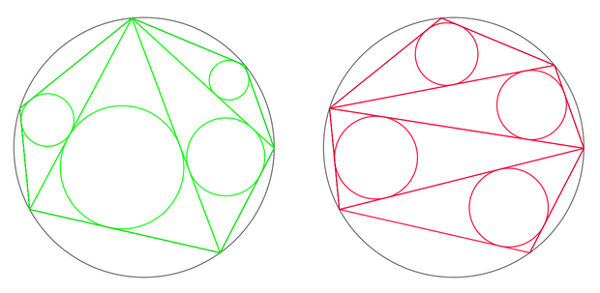“The success of most things depends upon knowing how long it will take to succeed.” — Montesquieu
Cutting Up

Choose any number of points on a circle and connect them to form a polygon.
This polygon can be carved into triangles in any number of ways by connecting its vertices.
No matter how this is done, the sum of the radii of the triangles’ inscribed circles is constant.
This is an example of a Sangaku (literally, “mathematical tablet”), a class of geometry theorems that were originally written on wooden tablets and hung as offerings on Buddhist temples and Shinto shrines during Japan’s Edo period (1603-1867). This one dates from about 1800.
In a Word

chirography
n. one’s own handwriting or autograph; a style or character of writing
What is this? It’s the signature of Treasury Secretary Jack Lew. When Lew was nominated for the post in January 2013, it threatened to appear on all U.S. paper currency for the duration of his tenure.
Barack Obama said, “Jack assures me that he is going to work to make at least one letter legible in order not to debase our currency, should he be confirmed as secretary of the Treasury.” He did so — the current signature is below.
Lew’s predecessor, Timothy Geithner, had a similarly incomprehensible signature and produced a more legible version for the currency. “I took handwriting in the third grade in New Delhi, India,” he said, “so I probably did not get the best instruction on handwriting.”

“A Bit of Spanish”

This pleasing cryptarithm, by Bob High, appears in the September/October 2014 issue of MIT Technology Review. If each letter stands for a digit, what arithmetic sum is enciphered here?
You Are Here
Metaphors for life:
“A theater in which the worst people often have the best seats.” — Aristonymus
“A hospital in which every patient is possessed by the desire to change his bed.” — Charles Baudelaire
“A maze in which we take the wrong turning before we have learned to walk.” — Cyril Connolly
“A garish, unrestful hotel.” — Joseph Conrad
“Like eating artichokes — you’ve got to go through so much to get so little.” — Tad Dorgan
“For most men … a search for the proper manila envelope in which to get themselves filed.” — Clifton Fadiman
“A library owned by an author. In it are a few books which he wrote himself, but most of them were written for him.” — Harry Emerson Fosdick
“An onion, and one peels it crying.” — French proverb
“The only riddle that we shrink from giving up.” — W.S. Gilbert
“Life is something like this trumpet. If you don’t put anything in it, you don’t get anything out.” — W.C. Handy
“A succession of frontispieces. The way to be satisfied is never to look back.” — William Hazlitt
“A long headache in a noisy street.” — John Masefield
“A foreign language: all men mispronounce it.” — Christopher Morley
“A party: one arrives long after it’s started, and one’s going to leave long before it’s over.” — Robert Morley
Black and White
The Edinburgh Fairy Coffins

In early July 1836, three boys searching for rabbits’ burrows near Edinburgh came upon some thin sheets of slate set into the side of a cliff. On removing them, they discovered the entrance to a little cave, where they found 17 tiny coffins containing miniature wooden figures.
According to the Scotsman‘s account later that month, each of the coffins “contained a miniature figure of the human form cut out in wood, the faces in particular being pretty well executed. They were dressed from head to foot in cotton clothes, and decently laid out with a mimic representation of all the funereal trappings which usually form the last habiliments of the dead. The coffins are about three or four inches in length, regularly shaped, and cut out from a single piece of wood, with the exception of the lids, which are nailed down with wire sprigs or common brass pins. The lid and sides of each are profusely studded with ornaments, formed with small pieces of tin, and inserted in the wood with great care and regularity.”
Some accounts say that the coffins had been laid in tiers, the lower appearing decayed and the topmost quite recent, but Edinburgh University historian Allen Simpson believes that all were placed in the niche after 1830, about five years before the boys discovered them.
Who placed them there, and why, remain mysterious. Simpson suggests that they may be an attempt to provide a decent symbolic burial for the victims of murderers William Burke and William Hare, who had sold 17 corpses to local doctor Robert Knox in 1828 for use in anatomy lessons. But 12 of Burke and Hare’s victims were women, and the occupants of the fairy coffins are all dressed as men.
So investigations continue. The eight surviving coffins and their tiny occupants are on display today at the National Museum of Scotland.
Podcast Episode 40: The Mary Celeste: A Great Sea Mystery

In 1872 the British merchant ship Mary Celeste was discovered drifting and apparently abandoned 600 miles off the coast of Portugal. In this episode of the Futility Closet podcast we’ll review this classic mystery of the sea: Why would 10 people flee a well-provisioned, seaworthy ship in fine weather?
We’ll also get an update on the legal rights of apes and puzzle over why a woman would not intervene when her sister is drugged.
Rough Cuts

In 1968, artist Tim Ulrichs released Schleifpapier-Schallplatten, a set of 13 discs made from commercial sandpaper in various degrees of coarseness, with blank center labels. They were billed as “monosandpaper records.”
V.A. Wölfli’s industrial noise composition “Pferd/Horse/Elastic” was named after the Pferd company’s steel-cutting discs — he simply put 100 of the construction-duty grinding wheels inside record covers.
The first single by the Dust Breeders, “Sandpaper Mantra” (1989), was a 7-inch piece of sandpaper inside a record sleeve. Their 1995 composition “I’m Psycho 4 Yur Love” swapped these materials, with a sandpaper sleeve housing a vinyl record that gets scratchier every time it’s removed.
The Durutti Column’s The Return of the Durutti Column (1980), the Feederz’ Ever Feel Like Killing Your Boss? (1984), and Illusion of Safety’s Illusion of Safety (1999) were all released in sandpaper sleeves.
This may have been an homage to Guy Debord’s 1957 autobiography, Mémoires, which was bound in a sandpaper cover in order to destroy any book placed next to it.
(From Craig Dworkin, No Medium, 2013.) (Thanks, Vinny.)
Land of Opportunity

Auguste Bartholdi patented the Statue of Liberty. In 1879, seven years before its dedication in New York Harbor, the French sculptor filed a one-page abstract describing his “design for a sculpture”:
The statue is that of a female figure standing erect upon a pedestal or block, the body being thrown slightly over to the left, so as to gravitate upon the left leg, the whole figure being thus in equilibrium, and symmetrically arranged with respect to a perpendicular line or axis passing through the head and left foot. The right leg, with its lower limb thrown back, is bent, resting upon the bent toe, thus giving grace to the general attitude of the figure. The body is clothed in the classical drapery, being a stola, or mantle gathered in upon the left shoulder and thrown over the skirt or tunic or under-garment, which drops in voluminous folds upon the feet. The right arm is thrown up and stretched out, with a flamboyant torch grasped in the hand. The flame of the torch is thus held high up above the figure. The arm is nude; the drapery of the sleeve is dropping down upon the shoulder in voluminous folds. In the left arm, which is falling against the body, is held a tablet, upon which is inscribed ‘4th July, 1776.’ This tablet is made to rest against the side of the body, above the hip, and so as to occupy an inclined position with relation thereto, exhibiting the inscription. The left hand clasps the tablet so as to bring the four fingers onto the face thereof. The head, with its classical, yet severe and calm, features, is surmounted by a crown or diadem, from which radiate divergingly seven rays, tapering from the crown, and representing a halo. The feet are bare and sandal-strapped.
Bartholdi also received copyright 9939G for his “Statue of American Independence,” and architect Richard Morris Hunt received copyrights for the pedestal.
Barry Moreno’s Statue of Liberty Encyclopedia (2005) recounts the memory of a German immigrant who encountered the statue in 1911: “I remember we see Statue of Liberty. Gus asked me, ‘What’s the statue?’ And then we’re looking … and his father say, ‘That’s Christopher Columbus.’ And I put my two cents out. I say, ‘Listen, this don’t look like Christopher Columbus. That’s a lady there.'”

